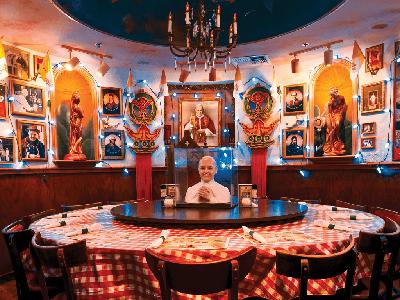How many angels can dance on the head of a pin?
Description
The question “How many angels can dance on the head of a pin?” is typically used as a mocking retort to the sorts of philosophical and especially theological questions that are thought to be of little usefulness and a general waste of effort. It’s especially used in reference to philosopher theologians of the Middle Ages like Scholastics including Thomas Aquinas and Duns Scotus. While the material conditions of people in the world were those of misery and squalor (so it is supposed) these folks were sitting in their ivory towers thinking about useless questions instead of doing science and inventing things. As you might guess, I don’t share this perspective and as a kind of subversion of the retort I’d like to appropriate it. The question “How many angels can dance on the head of a pin?” is not a question anyone actually ever asked. It’s a straight up caricature. But Medieval Scholastic philosophy did have plenty of talk about angels. Why? And could angels have any modern intellectual relevance?
In what follows I propose that angels were used in Medieval Scholastic philosophy as subjects for thought experiments. In such thought experiments the properties of angels were not those primarily of angels as described in biblical texts but more of an idealized notion serviceable to philosophical exercises. I propose that these sorts of philosophical angels can still be used to explore questions we find interesting today in thought experiments pertaining to cognition and consciousness. With an understanding of thought experiments as idealizations which transcend particularity in order to achieve generality I’ll go through various stages of generalization of consciousness from its particular human form to its most general form. This process moves into the complete abstraction of consciousness from any of its particular physical instantiations in order to explore its most essential features, though with our present knowledge this can only be the outline of a conceptual scaffolding since we don’t currently know what the essential features of consciousness actually are, or what it even is. And this will lead back to speculation about the nature of angels and what their nature might be.
When Medieval philosophers like Aquinas and Scotus talked about angels they did not get into historical scholarship about the way angels were understood at the times that the biblical texts were written. Or the way angels were understood during the Second Temple period with the writing of pseudepigraphal texts like the Book of Enoch. This is a fascinating subject and on this subject I’d recommend the work of Michael S. Heiser in his books Angels and The Unseen Realm. In Biblical texts angels are messengers. That’s what the Greek angelos (ἄγγελος) means. Also the Hebrew malak (מֲלְאָךְ). There’s not much information given about their metaphysical nature. But it is their metaphysical nature that is most interesting to the Medieval philosophers.
The most important attribute of angels for philosophical purposes is that they are non-corporeal. Angels do not have physical bodies. So they are very unlike us humans. Yet they are also like us humans in a very significant aspect: they are conscious beings. They’re not only conscious but also self-conscious, intelligent, and rational, again like humans. In our regular experience we only know of one kind being that is self-conscious, intelligent, and rational: human beings. And we have good reason to believe that these attributes are essentially connected to our physical bodies and especially our brains. The idea that a being could be self-conscious, intelligent, and rational without a physical body or even just a physical brain conflicts with our regular experience. But that’s why it’s interesting.
An excellent resource on the use of angels in Medieval philosophy is Martin Lenz and Isabel Iribarren’s Angels in Medieval Philosophical Inquiry: Their Function and Significance, which is a collection of essays on the subject. In particular I recommend the chapter by Dominik Perler titled Thought Experiments: The Methodological Function of Angels in Late Medieval Epistemology. In his essay Perler works with a definition of the thought experiment from The Routledge Encyclopedia of Philosophy, given by Timothy Gooding, whom he quotes: “A thought experiment is an idealization which transcends the particularity and the accidents of worldly human activities in order to achieve the generality and rigour of a demonstrative procedure.” I think this is an excellent definition for a thought experiment. If you want to get at the essence of a concept a thought experiment is a way of looking at it in the most generalized way possible. There are certain concepts like language, rationality, and possibly self-consciousness (of the most reflective sort) that we only find in human beings. How can we think about these concepts in their general form when we only have one kind of example from actual experience? We have to use our imaginations. And so we make thought experiments.
Perler notes that thought experiments take different forms in different ages. I would say that they make use of the images that are readily available in the culture. “Today, of course, philosophers hardly speak about angels. They prefer talking about brains in the vat, brains separated from the body and sent to another planet, zombies, or people living in a black-and-whiteworld.” We take our ideas from the culture: from religion, myth, literature, and film. But are these necessarily fictional? Perler makes an interesting distinction: “Of course, one needs to make a crucial distinction when talking about thought experiments. They can be understood either as scenarios involving purely fictitious entities (e.g., brains in the vat), or as scenarios appealing to entities that have real existence or could in principle have real existence, but are considered under ideal conditions (e.g., the scientist Mary who has all knowledge about colours). Since medieval authors took angels to be real entities, endowed with real causal power and interacting with other real entities, they were certainly not interested in thought experiments in the first sense [fictitious entities]. They were rather focusing on thought experiments in the second sense, analyzing angels as real creatures that transcend the material world and therefore enable us to examine cognitive activities in its purest and most ideal form, which is not subject to material constraints.”
I mentioned before that no Medieval person really asked “How many angels can dance on the head of a pin?”. But we can find examples of something kind of close. In the Summa Theologiae Thomas Aquinas asked the question: “Whether several angels can be at the same time in the same place?” (Summa Theologiae, First Part, Question 52, Article 3) This he answered in the negative: “I answer that, There are not two angels in the same place.” I’d actually answer the question differently I think. But what’s important is that the question makes sense to ask. We assume here that angels are immaterial. So there are questions that arise regarding the relation of immaterial things to space. Does something immaterial take up space? Could it take up space under certain circumstances? If the specific question about angels seems too remote, think about other immaterial things. First, consider mathematical sentences like 1+1=2. Does that take up space? It would seem not to. It’s just not a spatial kind of thing. Second, consider a field as understood in physics? A field is “a physical quantity, represented by a scalar, vector, or tensor, that has a value for each point in space and time.” Some fields probably have actual physical existence. In quantum field theory certain fields are understood to be the most basic building block of physical reality that give rise to everything else. But other fields are more abstract, especially since we can invent all kinds of fields to suit our purposes. For example, we can imagine a temperature field where every point in a given volume has a certain scalar temperature value. This kind of field would obviously be spatial in nature since it is defined over a given region of space. But it’s not exactly a physical thing either. It’s just a set of numbers. These two kinds of immaterial things have very different relations to space. For any kind of immaterial thing, including angels, it’s reasonable to ask which kind of relation to space it has. How many mathematical sentences, such as 1+1=2, can fit on the head of a pin? In the asking of that question we can see that mathematical sentences just aren’t the kinds of things that take up space or subsist in space at all. That’s an interesting feature of mathematical sentences.
Let’s look at another Medieval example. In his article Dominik Perler looks at the work of Duns Scotus and William of Ockham on the subject of perception. They framed the issue as one of how angels could have cognition of things in the world. Physical beings perceive the world through their physical senses. But nonphysical beings wouldn’t have sense organs of this sort. They would need other sorts of cognitive devices “to make things cognitively present to them.” Both Scotus and Ockham held that “every cognition requires a cognitive act and a cognitive object.” But they had different views about what that cognitive object would be. For Scotus, “the appropriate object for an intellectual act is the essence of a thing.” For Ockham, “the appropriate object for an intellectual act is the individual thing with its individual























